|
Left - Muskrats measure from 16 to 28 inches in length, half of that being the tail, which is used as their main means of propulsion. Picture from Wikipedia and taken by D. Gordon E. Robertson Middle- Here's Johnny preparing to set a carrot baited 110 Conibear trap. Photo by author. Right - Johnny points out fresh muskrat droppings, on a floating log that's crying for a log set! Photo by author. Do you remember my muskrat problem? A couple issues back I reveal my greatest failure (to date) in my efforts in managing Fyrne Lake. After months of research, visits with two lake management consultants, hours of reading research papers on the internet and sifting through a pile of pond management magazines I had pieced together my management plan. I was excited and ready to jump in. The plan involved removing unwanted fish (small bass, stripes and catfish), adding 1000s of crappie each year, stocking a variety of baitfish species and adding artificial and natural structure. All areas were progressing well except for one, adding natural structure. Dropping trees in the lake and creating brush piles was simple, but in a 110 acre lake with almost 8 miles of shoreline it wasn’t humanly possible to add all the natural structure the lake required. Plus, while the trees, branches and artificial structure I was placing in the lake was great cover for bass and crappie, they provided only moderate protection for baitfish and gamefish fry. The only real long-term solution was adding aquatic plants… acres of them! The right combination of aquatic plants would form a dense protective nursery along the shoreline of Fyrne Lake to maximize baitfish reproduction. Then this abundant food supply would fatten up our gamefish to enviable sizes. At least, that was the plan. I had picked out several plant species that would fill the bill and not threaten to take over the lake’s surface by stretching out into open water. I had done my homework, purchased my starts and planted them behind protective fence circles to give them a chance to establish. At that point the battle began. The muskrat, being smarter and more agile than the 40+ pound grass carp that inhabited Fyrne Lake, soon learned they could climb over the fence and consume my expensive salad. A couple years of battles ensued between me and the muskrats. Bottom line, THEY WON, I LOST. After countless hours of effort, various fencing designs, multiple shipments of plant starts and way, way too much time and money, I surrendered. There were too many intelligent rats in the lake and only one of me… and they had figured me out! Now, my story doesn’t end there. No, I shared the paragraph above to bring you up to date on where the situations stood in January of this year (2016). Several years have now passed since my last battle with these challenging creatures and they have been happily going about what muskrats do so well, eating anything green in the lake that the grass carp didn’t get to first! There bigger cousin, the beaver, had also moved into the lake. Between the two of them, the lake was becoming crowded and damage was becoming evident along the shoreline with dens, damaged trees and the continued absence of aquatic plants. I even found evidence of a muskrat den along the dam! This was dangerous! Beaver and muskrat can burrow completely through an earthen dam causing severe damage, weakening the dam and requiring immediate repair. Luckily, I caught this burrow early. But, the danger wasn’t going to go away on its own. It was time to call in reinforcements! I called Kelly Locke, who handled the pest control on our farm. He didn’t trap aquatic mammals, but he knew who I should contact, a gentleman by the name of Johnny Copeland at Copeland’s Beaver & Critter Control. Johnny grew up trapping alongside his father. It’s in his blood. Trapping to him is like fishing or hunting to most of us. It’s his chance to get out into God’s creation, enjoy its beauty and absorb the peace of God’s presence. Like us, it’s icing on the cake to actually catch, shoot or trap something. Right now, Johnny has a day job. But he dreams about eventually growing his trapping business into a fulltime job and from what I’ve seen, I believe he will achieve his goal! He’s already providing beaver control for several farms, predator control for multiple land owners and building a growing list of satisfied customers where he’s removed unwanted living (or dead) animals from in, under or around their home. He has a dream, a plan and the willingness to do the work to get it done. I don’t see how he won’t eventually achieve his dream. To do my part, I hired Johnny to thin out the muskrat and beaver on Fyrne Lake. That decision turned out to be the beginning of a whole new learning experience! I wanted to learn all about what he did and what it takes to be a successful trapper, so I accompanied him on his boat as he left the landing to scout out the lake. It was a couple hours before dark as we cruised along the shoreline looking for signs… signs of beaver and muskrat activity. He explained that beaver eat the bark, twigs and leaves off trees while muskrat consume aquatic plants (I knew that!), ground vegetation and when the opportunity presents itself, fish, turtles and invertebrates. He said to keep an eye out for damaged trees, floating branches with the bark stripped off and den holes along the shoreline. It wasn’t long before we saw definite holes in the bank right at the waterline. We slipped up to one in our boat, Johnny hopped out and then picked up a fallen tree branch to use as a probe. With it he discovered that the hole extended quite a ways back into the bank, eventually angling up beyond his reach. This was definitely created by a beaver! As we prepared to set a trap at its opening, Johnny explained that even though he was certain a beaver originally constructed this den, it may not currently be occupied by one. However, that doesn’t mean that it was unoccupied. Muskrat often move in to abandon beaver dens. The good news was that we were after both prey and Johnny set the trap accordingly. He chose a 330 Conibear instant kill trap. It was large and powerful enough to dispatch a full grown beaver, but sensitive enough to trip and eliminate a juvenile muskrat. Setting such a large and powerful trap is tricky and dangerous. Johnny, made it seem easy setting the spring tension and trigger, then staking it down in a vertical position across the den’s entrance. He then gathered random branches sticking them down on either side of the trap to eliminate gaps that our target could slip through and thereby encouraging them to take the easy route… through the opening of our trap! At that point I thought we were done and ready to move on. I was wrong. Johnny took out his secret weapon, beaver castor. Castor or castoreum is the yellowish liquid secreted from the sexual scent glands of a beaver. This is NOT the castor oil your parents or grandparents took as medicine as a child. That medicinal castor oil was made from pressing the beans from the castor oil plant (Ricinus Communis). No, this castor oil is secreted by a beaver while urinating to mark their territory and attract potential mates. The only way to get it is through removing the castor sacs from a beaver. This oil is expensive, but luckily it only takes a few drops to accomplish Johnny’s goal. Carefully, he placed a precious measure of this potent smelling fluid on the trap. Now our scent was covered and a “BEAVER HAS BEEN HERE” signal was broadcasting at full volume! On down the lake we moved, setting traps across the entrance of every promising den site. Eventually, we reached the top of the lake, a mostly shallow area where Coon Creek flows into the lake. It turns out this shallow marshy area was an ideal habitat for muskrat and beaver. The periodically flooded shoreline begins with a boggy grass buffer giving way to a stand of horsetail and grove of willow trees. Beaver LOVE willow trees and the stumps and felled trees were evidence to that truth! Droppings litter the tops of floating logs betraying the presence of muskrats. We had just found the home where most of our trouble emanated. And now our real work began. Johnny jumped out of the boat and waded along the shore. He was looking for runs. Runs are channels dug out by beaver and muskrat to move to and from the lake from their dens with ease. Right beside a log piled with muskrat droppings he found one. It was deep, much too deep to be made by muskrat. It had to be a beaver run. Muskrat are known for taking advantage of their bigger cousin’s work. They claim abandon beaver dens (as I mentioned earlier), utilize their underwater highways and even feast on the foliage of their downed trees. Muskrats have learned to take advantage of the opportunities they encounter… like my costly (and muskrat consumed) efforts at starting aquatic plants in Fyrne Lake. Yes, I needed to remove the beaver, they were the main threat to the dam. However, my more immediate target was the muskrat population. They had outsmarted me in my repeated attempts to establish aquatic plants. I encouraged Johnny to focus a good portion of his efforts directly toward my nemesis. Up to the challenge, this skilled trapper set four distinctly different types of trap settings to maximize our potential for immediate success. He first went for the floating log with the pile of muskrat droppings. He used a smaller 110 Conibear trap on the log near the droppings. He suspended the trap vertically by using two long branches threaded through each side and pushed down into the lake bottom. He then pulled out two pieces of carrot and pushed them onto the suspended trigger wires. And, of course, he added a small amount of muskrat castor. He then moved toward shore to create a pocket set. A pocket set involves creating a single path toward a bait allowing you to control how your target will approach making it easier to place the trap and ensure success. Johnny chose a large tuff of grass, created a path to the center and a pocket within. There he placed another carrot baited, castor scented 110. Then Johnny started scanning the area. He was looking for a trail on which to place his colony trap. A colony trap is a long narrow cage type live trap. Each end has a one way trap door. When located well, a colony trap has been known to catch multiple muskrat overnight. It wasn’t long before Johnny located a trail and placed the trap. The sun was over the horizon and it was getting hard to see without a light. But, Johnny wanted to place one more set. I think it was his favorite of the day. He took a 5 foot two by four board out of the boat, hammered a large nail all the way through about 4 inches down from the top until all the available point of the nail extended out the opposite side. He then took a half corn cob and pushed it long ways onto the nail point. Next, Johnny stuck the board at an angle into the creek bed in approximately 2 foot of water creating a perfect ramp for a muskrat to climb up to rest upon and have a snack. Now it was time to choose the trap. He picked up a #1 single long spring foot hold trap. A foot hold trap looks like what I remember seeing in cartoons as a child and function very much as their name implies. There are two spring loaded jaws that open to form a circle with a trigger pan in the middle. Depress the pan and the jaws close immediately upon whatever touched it, most often a foot. This type of trap doesn’t kill, and depending upon the animal, doesn’t even injure. But, it does “trap” them in place, assuming you have the trap secured well with a chain. Our purpose was to kill the animals in a humane way. We didn’t want them to suffer overnight with a trap around their ankle. Johnny accomplished this by loosely placing the trap on the board above the water line along the path the muskrat would have to take to reach the corn. The trap was attached to the board by a chain long enough to reach the bottom of the surrounding two foot deep water. If a muskrat set off the trap, both would fall in the water and the weight of the trap would hold the muskrat under until he drowned. Our first night of work was done! We had multiple traps out in a variety of sets and we did it on a beautiful and clear March evening. As we packed up the boat to head back to the landing we saw a lone muskrat in the dim light swimming across the cove not 50 feet ahead. As I watched the wake spread out as his head cut through the water I felt a tug of guilt. I had seen them as the invader… but at that moment I felt like the intruder. I consoled myself by remembering that my efforts were an attempt to protect Fyrne Lake and bring its ecosystem back into balance. Removing the over population of muskrat was key to being successful. It didn’t make me feel any better, but I knew it was necessary. I guess the question is… would this effort be successful? Check out the next issue to discover the answer. Left - Colony traps are constructed from wire mesh, with a one-way trap door located on both ends.
Photo by author. Middle - Johnny Copeland setting a 330 Conibear trap. Photo by author. Right - This picture shows a typical log set, utilizing a carrot-baited 110 Conibear trap. Photo by author |
AuthorKevin Griffith Archives
September 2018
Categories |
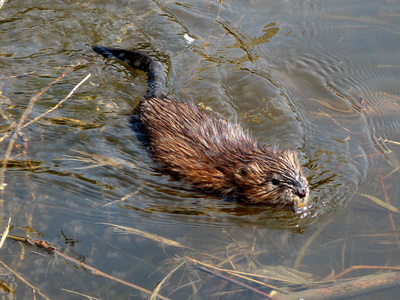
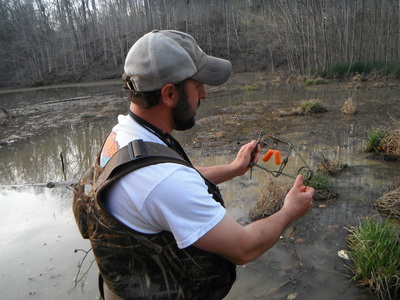
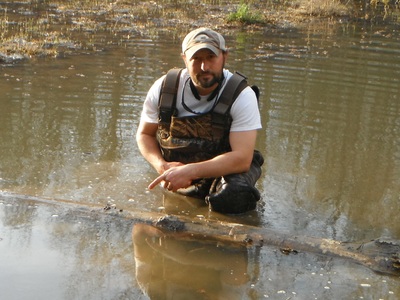
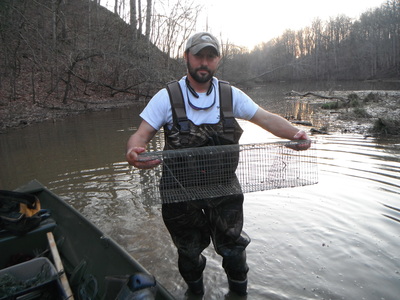
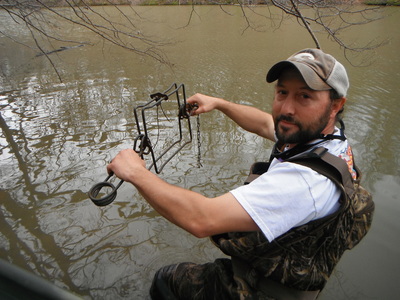
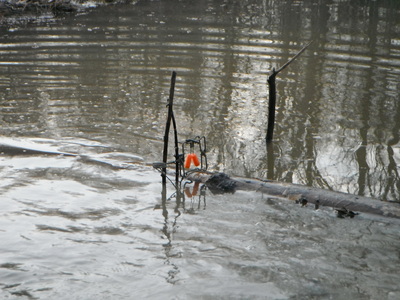
 RSS Feed
RSS Feed